Since expanding my home outside of the RV, I’ve been a bit scattered as far as tools and other renovations bits and bobs go. I’ve had my shed ‘done’ for months now, but just haven’t been able to prioritize the tool organization project. I have kept it in mind, looking for storage solutions, like a tool chest or even a dresser, but haven’t found anything.
One of the things I did decide on very early in my thought process was to build a workbench. I found a plan for a workbench that looked very easy to make and which would afford me not just a work surface, but also some storage. After I bought my table and circular saws, I just needed a nice free day to do the project. Well, it took almost two months, but today was the day!
I bought my materials in town on Friday. The workbench plans claim that it can be built for 50USD, but this being Canada, the project cost me 101CAD all in, including two carpenter pencils and some wood glue. I didn’t have to buy any screws, so that saved me some money. Lumber was 15 2x4s and one sheet of plywood. The workbench plan is really clever as it uses almost the entire materials and has very little waste.
Buying the lumber was very disheartening since it was all crap. Even the ‘best’ 2x4s were warped and chipped and the edges of the plywood were delaminated. I understand now why Charles gets all his lumber in Glasgow, MT. He says it’s not just in Assiniboia at the different home stores that he sees bad lumber, but that he had the same problem in Manitoba. Just another case of Canadians getting shafted, with our good lumber going to the States, we having to pay a premium on the garbage the Americans won’t take, and then having to pay taxes and duty to reimport our own wood.
I had the lumber yard do all but one of the cuts on my plywood so that it would be easier to bring home and so I wouldn’t have to wrangle a huge sheet on my own and try to make straight cuts. They weren’t too keen on doing that for me, even at $2 a cut ($4 total since the first cut was free), but they eventually agreed to.
Saturday was way too damp and drizzly to work on this project, but it was bright and sunny, albeit cold (8C/46F) at 8:00 this morning. The forecast called for the day to get increasingly cold, overcast, and windy, so I headed right out to cut all my lumber… and make some space in the workshop. This is what I was starting with:


I used both my circular and table saw, depending on the length of the piece I was cutting, and found the process much more laborious than I would have with a miter saw. I’ll definitely get one again once I start building in earnest. Both my table saw and circular saw worked great and I felt safe using them.
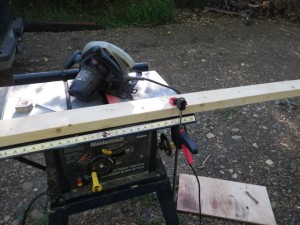
Now, here are some examples of the crap I had to buy.
I only agreed to buy this sheet of plywood knowing that I could plan the cuts for the worst of that water damage to be the waste bit.

This 2×4 was one of the best they had:

I labeled all my pieces as I cut them. It was rather like DIY IKEA!

I stacked all my pieces neatly so that I could find them all:

I later discovered that I had an F too many and was short a G because I forget to double check my cut sheet. I could have turn an F into a G, but it wasn’t worth pulling out the saws again and I just used an extra F and did without a G since they were supports and there were plenty of those to start with.
Then, it was time to start assembling! This is the frame for the worktop:
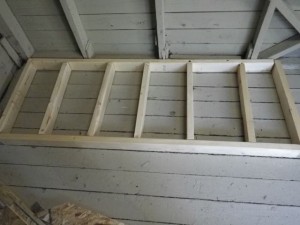
And here is the bottom shelf:

Notice that it is recessed so that you can sit at the workbench and have room for your legs. For such a simple design that makes such efficient use of materials, this workbench is really well thought out!
Legs on, height is perfect!
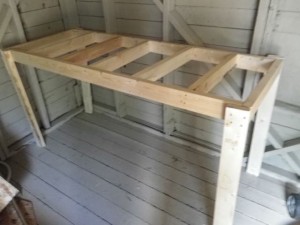
At this point, it was frighteningly wobbly, but the reinforcement was about the begin.
As suggested in the instructions, I used paint cans to hold the bottom shelf in place so I could screw it to the worktop. But I decided to screw the plywood to the bottom shelf before installing it, rather than after. Not sure why the instructions say to do it after as it was much easier to do it before.
I then built the frame for the top shelf and added the plywood to it. The easy bit was done and my project was starting to look like a workbench:
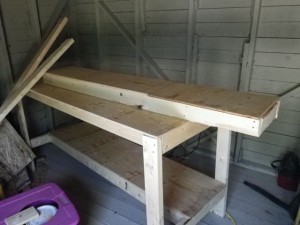
The next bit was tricky and where I ended up breaking for lunch near 1:00 p.m. I had to screw the top support legs and then get the thing up in the air and screwed to the workbench. I had to rearrange more stuff in the shed to get me room to manoeuver and the whole thing was very heavy, awkward, and fragile, but I got it done.
If you look at the plan, the legs for the top shelf don’t touch the floor, but mine do. The reason was going to be that I was working alone and didn’t have anyone to help me hold it up, but then I realised that the slope of the roof meant that this was as far up as I should be putting the shelf anyway.
Once the top shelf was secure, I added the backer boards. They are for added support, but also to keep things from falling off the back of the workbench and bottom shelf.
So here it is, and moved into its final position!
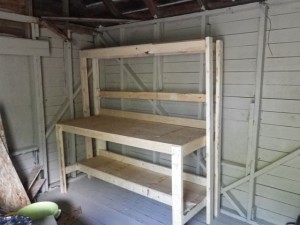
I didn’t hesitate to start using it for storage!
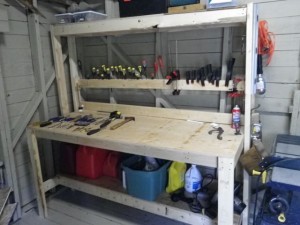
I was going to get pegboard, but I don’t think I need any. I’ll figure out an alternative way to store the tools that I have left to deal with (wrenches, pliers, hammers, and a few other odds and ends).
My favourite bit is my tape holder. I thought, “Hmm, a dowel would be useful for this and, oh, look, I have one handy. What are the odds?!” I just drilled a hole into the worktop and fit the dowel in it. It could also be a paper towel holder. Time will tell… 🙂

I was done for the day, but not done by far. Here’s what my makeshift table (plywood on sawhorses) still looks like. 🙂

And here’s a view of the whole workbench from the door:

The top shelf so far has my ‘sharp implements’ and ‘drilling’ containers I’ve had for years in office overhead cabinets, then my (empty) tool box that I’ll be able to fill and take to Mexico this winter, then my dad’s chisels with my socket wrench set over top, then my giant bucket of screws. Underneath, you can see my gas cans, tub of painting/drywall implements, oil for the truck, and then you’ll have to trust me that in the corner are my two drills and my circular saw.
So now the workbench part of the shed is done to a point. I still have to organize more containers for screws, nails, and odd bits, as well as sort out the last of the tools, but it’s a very good start.
If the weather is still good tomorrow, I will sort out the yard/garden corner of the shed to make it easy to take out my wheelbarrow, lawnmower, and ladder.
If you want to take on a project like this, check out Zac’s considerations for building a work bench.
I’m beat and wish I could get pizza or Chinese delivered! But since I can’t, I’m off to scrounge something yummy for dinner!






















